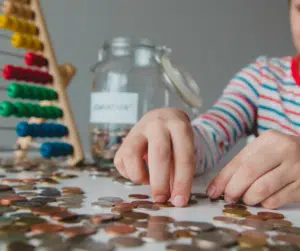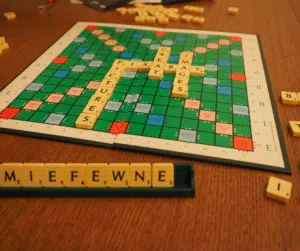5 Hands-On Ways To Make Math More Fun!
Like many homeschooling kids, my 8-year-old navigates between grade levels in math. She naturally excels in some areas, while others require more effort. I love that homeschooling allows us to set our own pace and also to make math more fun whenever we can! I am also really excited that we have just started using CTC Math, an online math curriculum that allows me (the parent) to FULLY customize her math lessons, creating a path of online lessons that spans different grade levels! I’m looking forward to seeing how CTC’s short, online video lessons and printable worksheets enhance her math journey with the ability to fully customize the experience. I think this curriculum will pair really well with some of the hands-on activities we try to do a home. Today, I want to share 5 hands-on ways to make math more fun for young kids–especially if you have elementary-aged children. These are some specific activities that have worked well for us, and I hope they work well for you, too!
1. Tangible Angles
My daughter just completed a lesson on angles with CTC math, and one of my favorite things about the online video was how illustrated the measurement of angles with a digital manipulative: two popsicle sticks fastened with a pivot joint that allows them to move into different angles and compare their sizes. This did a great job of virtually showing a hands-on approach that would be fun and easy to take this further by recreating your own angle measurement tool at home!
You can make a similar tool at home by laminating two strips of paper, punching a hole through them, and securing a brad through the hole! If your kids are anything like mine, they will love getting to build and create their own tool (AKA “be an inventor”). After making his or her own tool, your young learner can go around the house, assessing and comparing the different angles of everything!
If you have an extra-kinesthetic kid, like I do, then you can also have them try creating different poses with their bodies to show different angles. For instance, “Make a 90 degree angle by laying on the floor and putting your legs straight up in the air,” etc. Either way, getting kids physically involved with creating angles is a fun, hands-on way to show them how this mathematical concept plays a role in our lives, everyday!
Have you used any hands-on tactics to make angles more tangible in your homeschool? If so, please share with us in the comments!
2. Candy Word Problems, Fractions and Probability
Maybe more than any other subject, math offers plenty of opportunities to incorporate some sweet, hands-on incentives. This is especially true for elementary-aged learners!
Of course, one of the earliest ways to use candy in math is to teach the youngest learners how to count. Using candy manipulatives is also a great way to introduce and demonstrate the concepts of addition and subtraction. You can even use them them to teach about word problems and help kids recognize some of the key words that indicate which operation is needed, such as: “total, sum, altogether, increase, more than,” for addition, or “less, difference, decrease, or take away” for subtraction. Doing this is simple! Tell students some word problems related to candy, and have them act it out, using the pieces. Often kids will be surprised how easy it is to tell whether subtraction or addition is needed when they have something hands-on to work with.
Recently, I used Starburst candy in my daughter’s homeschool co-op group to illustrate fractions and introduce probability! (Starbursts are really good for this because they only come in a few colors.) We discussed how probability means “desired outcomes”/”total possible outcomes,” and I used candy to show how this works. For example, I might put 10 Starbursts in a paper bag. If your “desired outcome” is to randomly draw a red Starburst out of the bag, then we can find the probability of that outcome by making a fraction of: red Starbursts in the bag/total Starbursts in the bag! For example, if there are 3 red Starbursts in the bag, then you have a 3/10, or 30% chance, of getting the one you want on a random draw! If you’re teaching your kids some of these concepts, you can play around with different versions of this example to keep it hands-on and fun. And of course, enjoy a few Starbursts, too (or Skittles or Sour Patch Kids!)
3. Playing Shop
All kids love to play shop, and it’s such a fun and easy way to teach them about money values, addition and subtraction! This also makes an awesome addition to any worksheets or online lessons you are doing with your kids to teach them about money math. After reviewing the value of each coin several times (in your curriculum of choice and with the real thing), ask your kids to create a “store” using items from around the house! Have them mark each item with a price (less than a dollar works best to start with). Have a selection of coins available that makes up $1.00. Then take turns being the customer or store owner (or have your children take turns with each other. Someone has to count out the exact amount each time, and the other person has to make correct change!
If your children are more comfortable with money math, and/or just need to review these concepts, then you can make it more challenging by marking the “shop” prices higher and working with a larger selection of coins. Playing shop is a great way to create some fun memories with your kids, “play” with them a little, and help them gain greater confidence in their addition, subtraction, and money-math skills! This is also such an important, tangible life-skill and concept to pass on to our children in a world in which the money transactions they see most tend to be digital transactions.
4. Math Fact Fitness
Kids love to move, and they need to move–so much so that I’d argue that movement is a powerful teaching tool! Utilizing movement is a very simple, but fun, way to make math more engaging and even improve retention! (And I don’t know about you, but at my house, music is often a given when movement is involved!) Here are a few ways to try some “math fact fitness” a home!
- Use memorable melodies and/or strong beats to practice skip counting by numbers 1-12.Kids don’t just love to move; they need to move. I’d argue that movement can often be a powerful teaching tool. Utilizing movement in learning is a simple yet fun way to make math more engaging and even improve retention! (And, if your household is anything like mine, music often accompanies movement!) Here are a few ways to introduce some “math fact fitness” at home:
- Create a math-based workout. Encourage kids to skip count while doing jumping jacks, or hold a plank while solving a word problem. Alternatively, present a question with options A or B, and have them perform a fitness pose corresponding to the correct answer. For instance, you could hold up a clock and say, “If the clock shows ____, do 3 push-ups. If it shows ____, strike a downward dog pose.”
- Play your own version of “Red Light Green Light,” but make it “math-y!” Ask your child (or children) a math question. When a correct answer is given, the child who gave it gets to advance however many steps you say. Make it extra fun by having them do giant steps, ballerina twirls, crawl like a baby, etc!
5. Math Competitions and Challenges
Turning math into a competition or timed challenge always boosts engagement, make math-time more exciting and fun for kids! If you have more than one elementary-aged child, this can be as simple as seeing who can solve the most math-fact flashcards in one minute. If you have an only child, they can try to beat their own record! Write them down and keep up with successes. You could also let your kids “play detective” with a daily “Math Mystery” written on the board that includes math related problems to solve. (As a side note, if your child loves mysteries and you are trying to engage them in math, check out this amazing fiction series.)
Math games are another fun type of math competition/challenge! Two of my favorite, classic games involving math, which can be used for all ages, are Sorry and Scrabble (Scrabble is great, of course, because it hones spelling and math skills!) War is a math card game that never gets old and can be played to review addition, subtraction, multiplication and division!
Math competitions and challenges will motivate your child to jump into this type of math-pratice with enthusiasm, instead of dragging their feet. It will also motivate them to beat their siblings (or you) and see their own successes over past attempts! Another nice thing about timed challenges and games, in particular, is that they aren’t intimidating or stressful for the child who gets overwhelmed by too many worksheets.
One great thing about math is that it is an objective subject. The information is straightforward and true, in other words, which gives us (homeschool parents) the opportunity to approach this subject in many different ways depending on the diverse needs of our young learners. I personally think that, especially with math, the more ways you can approach it educationally, the better! I don’t really think you can go wrong by combining worksheets, online lessons, and as many math games as your kids want to play! A fun, multi-sensory approach to math will not only help your child understand more fully what they’re learning about now; it will also make math more approachable as they get older. (A very worthy goal!) Find even more ideas for making math more fun for students of all ages by checking out this article!
What are some of more favorite, hands-on strategies for making math more fun? Have you (or will you) try any of these at home? Do you use CTC Math, or do you have another curriculum you love? Leave us a comment and let us know!
Katie Gustafson has been a member of the world of “weird, unsocialized homeschoolers” for a long time–first as an alumnus and now as a homeschooling mom to a fiercely fun little girl! She’s very into anything creative, especially writing, dancing, and painting. She’s also particularly passionate about literature and owns more books than she will probably ever be able to read. However, she reassures herself with the belief that, in the event of a digital apocalypse, she’s cultivating a much-needed physical library for future generations. Katie is happy to contribute articles to Weird Unsocialized Homeschoolers, Hip Homeschool Moms and Sparketh. She also has a personal blog on writewhereuare.com.





